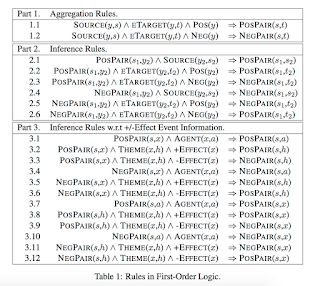Summary
In this talk, Dr. Deng
summarized their research work in the field of sentiment analysis aiming at
understanding the opinions in the text. As she discussed, sentiment can be generally
divided into three categories - positive, negative and neutral, and
specifically the positive and negative are more people’s concerns. Much work in
sentiment analysis and opinion mining have been done at both general document
level as well as fined grained levels such as sentence level, phrase level and
aspect level. Deng and her colleagues make a contribution at entity/event
level.
Dr. Deng indicated that some
implicit sentiment cannot be recognized merely relying on sentiment lexicons.
For example, in the following sentences:
Sentence: It is great that the bill was defeated.
There is a positive
sentiment explicitly expressed via the word “great”, and the target of this sentiment is the fact that “the bill was defeated”. It is not
difficult to detect that the writer or speaker shows a positive attitude
towards the fact. But it becomes more complicated to identify the person’s
attitude towards the target “bill”.
Dr. Deng stated that compared to detecting the explicit sentiment, it requires
inference to recognize the implicit sentiment.
To achieve the reference goal,
she and her colleagues develop inference rules (Table 1), and conduct extensive
experiments to demonstrate the inference ability of their rules. Besides, they
also developed computational models aiming at automatically infer sentiments.
In their model, they not only take into consideration the information from sentiment
analysis but also from other Natural Language Processing tasks. Results show
that their framework simultaneously beats the baselines by more than 10 points
in F-measure on sentiment detection and more than 7 points in accuracy on GoodFor/BadFor
(gfbf) polarity disambiguation.
Details about talk:
Title: Entity/Event-level
Sentiment Detection and Inference
Speaker: Lingjia Deng

